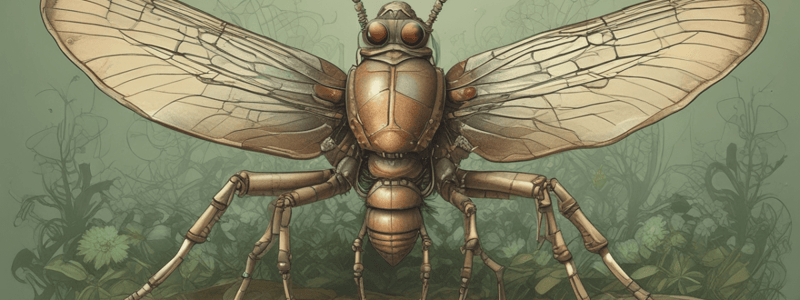Podcast
Questions and Answers
What is a characteristic feature of chelicerates' appendages?
What is a characteristic feature of chelicerates' appendages?
- They are all modified for swimming
- They have antennae
- They are segmented and branch-like
- The first pair is three-segmented and pincher-like (correct)
Which group of arthropods is exclusively terrestrial and prefers a humid environment?
Which group of arthropods is exclusively terrestrial and prefers a humid environment?
- Hexapods
- Chelicerates
- Crustaceans
- Myriapods (correct)
What is the number of body regions in chelicerates?
What is the number of body regions in chelicerates?
- One
- Four
- Two (correct)
- Three
Which of the following is NOT a characteristic of myriapods?
Which of the following is NOT a characteristic of myriapods?
What is the name of the first pair of mouthparts in chelicerates?
What is the name of the first pair of mouthparts in chelicerates?
How many classes are myriapods divided into?
How many classes are myriapods divided into?
What is a characteristic feature of crustaceans' appendages?
What is a characteristic feature of crustaceans' appendages?
Which group of arthropods is characterized by the presence of six legs in three pairs?
Which group of arthropods is characterized by the presence of six legs in three pairs?
What is a common feature of crustaceans and hexapods?
What is a common feature of crustaceans and hexapods?
Which group of arthropods has the largest species diversity and biomass in terrestrial habitats?
Which group of arthropods has the largest species diversity and biomass in terrestrial habitats?
What is the term for the type of appendages found in crustaceans?
What is the term for the type of appendages found in crustaceans?
What is the reason for the diverse range of limb specializations in arthropods?
What is the reason for the diverse range of limb specializations in arthropods?
Study Notes
Arthropods: The Limb Specialization of Chelicerates, Myriapods, Crustaceans, and Hexapods
Arthropods are a diverse group of organisms that share a number of common characteristics, including a segmented body, a hardened exoskeleton, and jointed appendages. These animals are divided into four major classes: Chelicerates, Myriapods, Crustaceans, and Hexapods, each with unique limb specializations that reflect their ecological niches and evolutionary histories.
Chelicerates: The Clawed Ones
Chelicerates are characterized by the presence of two distinct body regions: a cephalothorax and an abdomen. They have six pairs of appendages, the first two pairs being mouthparts and the following four pairs being legs. Unlike other arthropods, chelicerates do not have antennae. The first pair of mouthparts, known as chelicerae, are three-segmented and pincher-like, often resembling fangs in spiders. This group includes arachnids, such as spiders, ticks, mites, and scorpions.
Myriapods: The Many-footed Ones
Myriapods are characterized by the presence of numerous body segments, each bearing one or two pairs of legs. This group includes millipedes and centipedes. Myriapods are exclusively terrestrial animals and prefer a humid environment. They are typically found in moist soils, decaying biological material, and leaf litter. Myriapods are divided into four classes: Chilopoda (centipedes), Symphyla, Diplopoda (millipedes), and Pauropoda.
Crustaceans: The Hard-shelled Ones
Crustaceans are a very diverse class, with about 30,000 species. They are characterized by the presence of two pairs of antennae, mandibles as mouthparts, and biramous ("two branched") appendages, which means that their legs are formed in two parts. Crustaceans are predominantly aquatic, with a significant number of species being marine. Some crustaceans, such as the Isopoda (sowbugs and pillbugs), have invaded terrestrial habitats but remain closely associated with aquatic environments.
Hexapods: The Six-legged Ones
Hexapods are characterized by the presence of six legs (three pairs) in their body plan. They have a head, thorax, and abdomen, constituting three tagma. The thorax bears wings as well as six legs in three pairs. Many common insects, such as ants, cockroaches, butterflies, and flies, are examples of hexapods. Amongst the hexapods, insects are the largest class in terms of species diversity and biomass in terrestrial habitats.
In summary, chelicerates, myriapods, crustaceans, and hexapods each have unique limb specializations that reflect their ecological niches and evolutionary histories. These differences in body form and limb structure have allowed arthropods to occupy a wide range of habitats and play crucial roles in ecosystems worldwide.
Studying That Suits You
Use AI to generate personalized quizzes and flashcards to suit your learning preferences.
Description
Test your knowledge on the limb specializations of Chelicerates, Myriapods, Crustaceans, and Hexapods within the diverse group of arthropods. Explore the unique features of each class's limbs and how they are adapted to their ecological niches.




